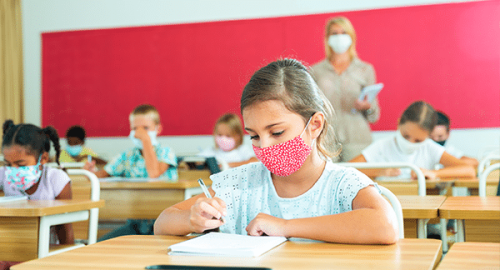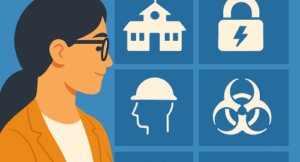The U.S. Department of Education (ED) clearly states its position on reopening schools: “We must keep opening school doors and welcoming students back into classrooms.”
In the Return to School Roadmap, the ED urges schools to re-engage students, parents, and staff so that everyone is comfortable coming back to school. The three “Landmark” priorities detailed in the Roadmap are meant to guide schools in accomplishing this substantial goal. Schools can also leverage ESSER funding from the American Rescue Plan (ARP) Act to purchase the tools needed to complete these recommendations.
Landmark 1: Prioritize Health and Safety
Keeping your school community healthy and safe involves screening all entrants for COVID-19 and denying entry to anyone with exposure risk. In their COVID-19 Handbook, the ED recommends students and staff screen themselves for symptoms at home, adding that district and school leaders should regularly remind people of the symptoms and help them get into the habit of checking for symptoms each day.
The ED also encourages schools to:
- Communicate policies with students, staff, and families to build their confidence in the school’s ability to keep everyone safe
- Encourage vaccinations
- Improve building ventilation where needed
- Continue following CDC guidelines, such as mask-wearing and social distancing
Schools can leverage technology to send a daily health screening questionnaire to staff and each student’s guardian. The best systems intelligently recommend if the student or staff member should stay home or attend school based on the provided answers and automatically compiles the data so school administrators can quickly see results, create robust reports, and have the visibility needed to make operational decisions. The most powerful systems integrate with your school visitor management system, enabling you to also screen visitors, track who is on campus, and promptly facilitate contact tracing when needed.
Landmark 2: Build Communities and Support Social, Emotional, and Mental Health
In a 2021 national report developed by Safe and Sound Schools and Raptor Technologies, school staff and administrators listed mental health crises, such as depression, suicide, and self-harm, as their most concerning safety threat. In the same survey, nearly 75% of students said they have experienced depression and/or anxiety from the pandemic.
Students need mental health services more than ever before, according to Dr. Scott Poland, Professor and Co-Director of the Suicide and Violence Prevention Office. Before COVID-19, suicide was the second leading cause of death in children over 10 years old. “We’re seeing increasing numbers of children even under the age of 10 threatening suicide now,” Dr. Poland shared on School Safety Today.
The ED recommends schools take the following actions:
- Assess student and staff social, emotional, and mental health needs
- Invest in effective strategies and training programs to address these needs
- Hire additional school counselors and mental health professionals
- Ensure inclusiveness in your school community
- Provide extracurricular opportunities to build community and advance students’ academic and emotional development
It is important to think ahead and have the tools to respond to student trauma or student mental health crises. Schools need a comprehensive emergency management system with a mobile, discreet team assist ability that empowers teachers and staff to summon the right support and have access to protocols for any situation, including, for example, a positive COVID-19 case, a fight in the hallway, or a full-scale campus emergency with multiple first responder agencies.
Landmark 3: Accelerate Academic Achievement
Remote learning has resulted in unfinished learning and/or learning loss for countless students. The ED recommends schools re-engage disconnected students through enrichment programs. When done correctly, these programs can drastically improve a student’s academic performance and help them return to grade level.
The ED also recommends schools:
- Identify learning gaps in their school community
- Invest in evidence-based strategies to address learning loss
- Provide high-quality career and technical education so students better understand career/college path
- Invest in educators and teachers
- Implement high-quality early learning opportunities
Volunteers can help with many of these tasks, such as tutoring students, presenting technical education, and organizing enrichment programs. This requires schools have an efficient method to recruit and track each volunteer and confirm they are safe to work with students.
How to Maximize ARP ESSER Funds
Districts are receiving an unprecedented amount of stimulus funding from the CARES Act, CRRSA Act, and ARP Act to address the impacts of COVID-19. The funding allows for expenses that help schools accomplish these Landmark priorities, including purchasing health screening tools, funding learning loss initiatives, and addressing the mental well-being of your students and staff.
Learn more about ESSER, and how to leverage your funds, in our Guide to K-12 Safe Reopening: Strategies for ESSER Funding to Protect Your School.





